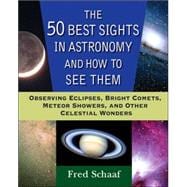
| Acknowledgments | p. vii |
| Introduction | p. 1 |
| Basic Information for Astronomical Observers | p. 5 |
| Field of View: 180[degree] (the Whole Sky) to 100[degree] (Naked-Eye Scan) | |
| The Starry Sky | p. 13 |
| Total Eclipse of the Sun | p. 18 |
| Meteor Shower or Storm | p. 22 |
| Fireball Meteor | p. 28 |
| The Northern Lights, or Aurora | p. 32 |
| Bright Satellite or Spacecraft | p. 36 |
| The Milky Way | p. 40 |
| Field of View: 100[degree] to 50[degree] (the Widest Fixed Naked-Eye Field) | |
| The Big Dipper and the North Star | p. 47 |
| The Orion Group of Constellations | p. 51 |
| The Summer Triangle Region | p. 54 |
| Field of View: 50[degree] to 15[degree] (Moderately Wide Naked-Eye Field) | |
| Venus and Mercury at Greatest Elongation | p. 61 |
| Venus, Jupiter, and Mars at Brightest | p. 65 |
| Bright Comet with Long Tail | p. 69 |
| Sirius, the Brightest Star | p. 77 |
| Other Bright Stars | p. 81 |
| Orion | p. 86 |
| Other Prominent Constellations | p. 92 |
| Field of View: 15[degree] to 1[degree] (Narrow Naked-Eye Field, Binoculars Field, and Wide-Telescopic Field) | |
| Total Eclipse of the Moon | p. 101 |
| Total Eclipse of the Sun Close-Up | p. 108 |
| The Moon at Full and Other Phases | p. 111 |
| Very Thin Crescent Moon | p. 114 |
| Lunar Conjunctions and Occultations | p. 120 |
| Planetary Conjunctions | p. 127 |
| Bright Comet Close-Up | p. 134 |
| The Hyades Star Cluster and Aldebaran | p. 136 |
| The Pleiades | p. 139 |
| Other Very Bright Large Open-Star Clusters | p. 143 |
| Orion's Belt and Sword | p. 146 |
| Algol, Mira, and Other Dramatic Variable Stars | p. 151 |
| Novae, Supernovae, and Supernova Remnants | p. 156 |
| Starriest Fields | p. 162 |
| The Sagittarius Milky Way Region | p. 165 |
| The Great Andromeda Galaxy | p. 170 |
| The Realm of the Galaxies | p. 175 |
| Field of View: 1[degree] to 0.1[degree] or Less (Medium to Narrow Telescopic Field) | |
| Overall Telescopic Views of the Moon | p. 181 |
| Close-Up Views of Lunar Craters and Other Features of the Moon | p. 185 |
| Sunspots and Other Solar Features | p. 190 |
| Partial Eclipses of the Sun | p. 195 |
| Transits of Mercury and Venus | p. 199 |
| Venus Near Inferior Conjunction | p. 202 |
| Jupiter and Its Moons | p. 207 |
| Saturn and Its Rings and Moons | p. 213 |
| Mars at Closest in a Telescope | p. 219 |
| Uranus, Neptune, and Other Dim but Important Worlds | p. 226 |
| A Colorful or Otherwise Striking Double Star | p. 230 |
| The Great Orion Nebula | p. 237 |
| A Rich Open Cluster | p. 243 |
| A Bright Globular Cluster | p. 249 |
| A Bright Planetary Nebula | p. 254 |
| A Bright and Structured Galaxy | p. 258 |
| Total Solar Eclipses, 2008-2024 | p. 262 |
| Major Meteor Showers | p. 263 |
| Total and Partial Lunar Eclipses, 2007-2017 | p. 264 |
| The Brightest Stars | p. 265 |
| Transits of Venus and Mercury | p. 266 |
| Glossary | p. 267 |
| Sources | p. 271 |
| Photo Credits | p. 273 |
| Index | p. 274 |
| Table of Contents provided by Ingram. All Rights Reserved. |
The New copy of this book will include any supplemental materials advertised. Please check the title of the book to determine if it should include any access cards, study guides, lab manuals, CDs, etc.
The Used, Rental and eBook copies of this book are not guaranteed to include any supplemental materials. Typically, only the book itself is included. This is true even if the title states it includes any access cards, study guides, lab manuals, CDs, etc.